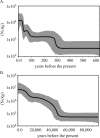JC virus evolution and its association with human populations
- PMID: 17005670
- PMCID: PMC1617318
- DOI: 10.1128/JVI.00441-06
JC virus evolution and its association with human populations
Abstract
The ubiquitous human polyomavirus JC (JCV) is a small double-stranded DNA virus that establishes a persistent infection, and it is often transmitted from parents to children. There are at least 14 subtypes of the virus associated with different human populations. Because of its presumed codivergence with humans, JCV has been used as a genetic marker for human evolution and migration. Codivergence has also been used as a basis for estimating the rate of nucleotide substitution in JCV. We tested the hypothesis of host-virus codivergence by (i) performing a reconciliation analysis of phylogenetic trees of human and JCV populations and (ii) providing the first estimate of the evolutionary rate of JCV that is independent from the assumption of codivergence. Strikingly, our comparisons of JCV and human phylogenies provided no evidence for codivergence, suggesting that this virus should not be used as a marker for human population history. Further, while the estimated nucleotide substitution rate of JCV has large confidence intervals due to limited sampling, our analysis suggests that this virus may evolve nearly two orders of magnitude faster than predicted under the codivergence hypothesis.
Figures



Similar articles
-
Utility of DNA viruses for studying human host history: case study of JC virus.Mol Phylogenet Evol. 2008 Feb;46(2):673-82. doi: 10.1016/j.ympev.2007.09.005. Epub 2007 Sep 18. Mol Phylogenet Evol. 2008. PMID: 17977749
-
Evolution of human Polyomavirus JC: implications for the population history of humans.J Mol Evol. 2002 Mar;54(3):285-97. doi: 10.1007/s00239-001-0009-x. J Mol Evol. 2002. PMID: 11847555
-
African origin of polyomavirus JC and implications for prehistoric human migrations.J Mol Evol. 2003 May;56(5):564-72. doi: 10.1007/s00239-002-2425-y. J Mol Evol. 2003. PMID: 12698293
-
JC virus genotyping offers a new paradigm in the study of human populations.Rev Med Virol. 2004 May-Jun;14(3):179-91. doi: 10.1002/rmv.428. Rev Med Virol. 2004. PMID: 15124234 Review.
-
The phylogeography of human viruses.Mol Ecol. 2004 Apr;13(4):745-56. doi: 10.1046/j.1365-294x.2003.02051.x. Mol Ecol. 2004. PMID: 15012753 Review.
Cited by
-
Assessing Host-Virus Codivergence for Close Relatives of Merkel Cell Polyomavirus Infecting African Great Apes.J Virol. 2016 Sep 12;90(19):8531-41. doi: 10.1128/JVI.00247-16. Print 2016 Oct 1. J Virol. 2016. PMID: 27440885 Free PMC article.
-
Positive Selection Drives Rapid Evolution of the meq Oncogene of Marek's Disease Virus.PLoS One. 2016 Sep 23;11(9):e0162180. doi: 10.1371/journal.pone.0162180. eCollection 2016. PLoS One. 2016. PMID: 27662574 Free PMC article.
-
Molecular epidemiology of merkel cell polyomavirus: evidence for geographically related variant genotypes.J Clin Microbiol. 2014 May;52(5):1687-90. doi: 10.1128/JCM.02348-13. Epub 2014 Feb 12. J Clin Microbiol. 2014. PMID: 24523477 Free PMC article.
-
Using HSV-1 genome phylogenetics to track past human migrations.PLoS One. 2013 Oct 16;8(10):e76267. doi: 10.1371/journal.pone.0076267. eCollection 2013. PLoS One. 2013. PMID: 24146849 Free PMC article.
-
A diverse virome in kidney transplant patients contains multiple viral subtypes with distinct polymorphisms.Sci Rep. 2016 Sep 16;6:33327. doi: 10.1038/srep33327. Sci Rep. 2016. PMID: 27633952 Free PMC article.
References
-
- Ayub, Q., A. Mansoor, M. Ismail, S. Khaliq, A. Mohyuddin, A. Hameed, K. Mazhar, S. Rehman, S. Siddiqi, M. Papaioannou, A. Piazza, L. L. Cavalli-Sforza, and S. Q. Mehdi. 2003. Reconstruction of human evolutionary tree using polymorphic autosomal microsatellites. Am. J. Phys. Anthropol. 122:259-268. - PubMed
-
- Bamshad, M., T. Kivisild, W. S. Watkins, M. E. Dixon, C. E. Ricker, B. B. Rao, J. M. Naidu, B. V. R. Prasad, P. G. Reddy, A. Rasanayagam, S. S. Papiha, R. Villems, A. J. Redd, M. F. Hammer, S. V. Nguyen, M. L. Carroll, M. A. Batzer, and L. B. Jorde. 2001. Genetic evidence on the origins of Indian caste populations. Genome Res. 11:994-1004. - PMC - PubMed
-
- Bernard, H.-U. 1994. Coevolution of papillomaviruses with human populations. Trends Microbiol. 2:140-143. - PubMed
Publication types
MeSH terms
Substances
LinkOut - more resources
Full Text Sources
Other Literature Sources

